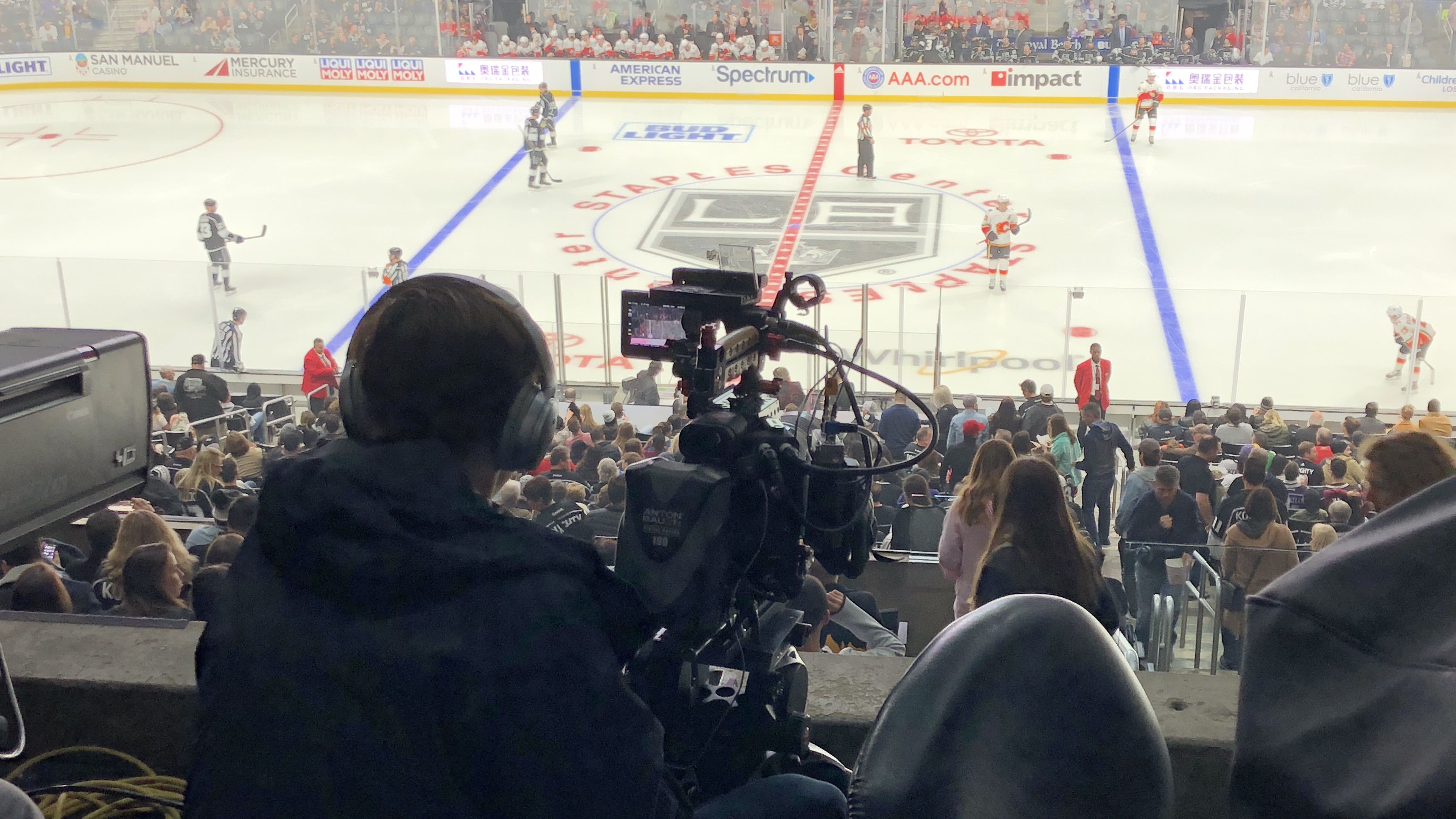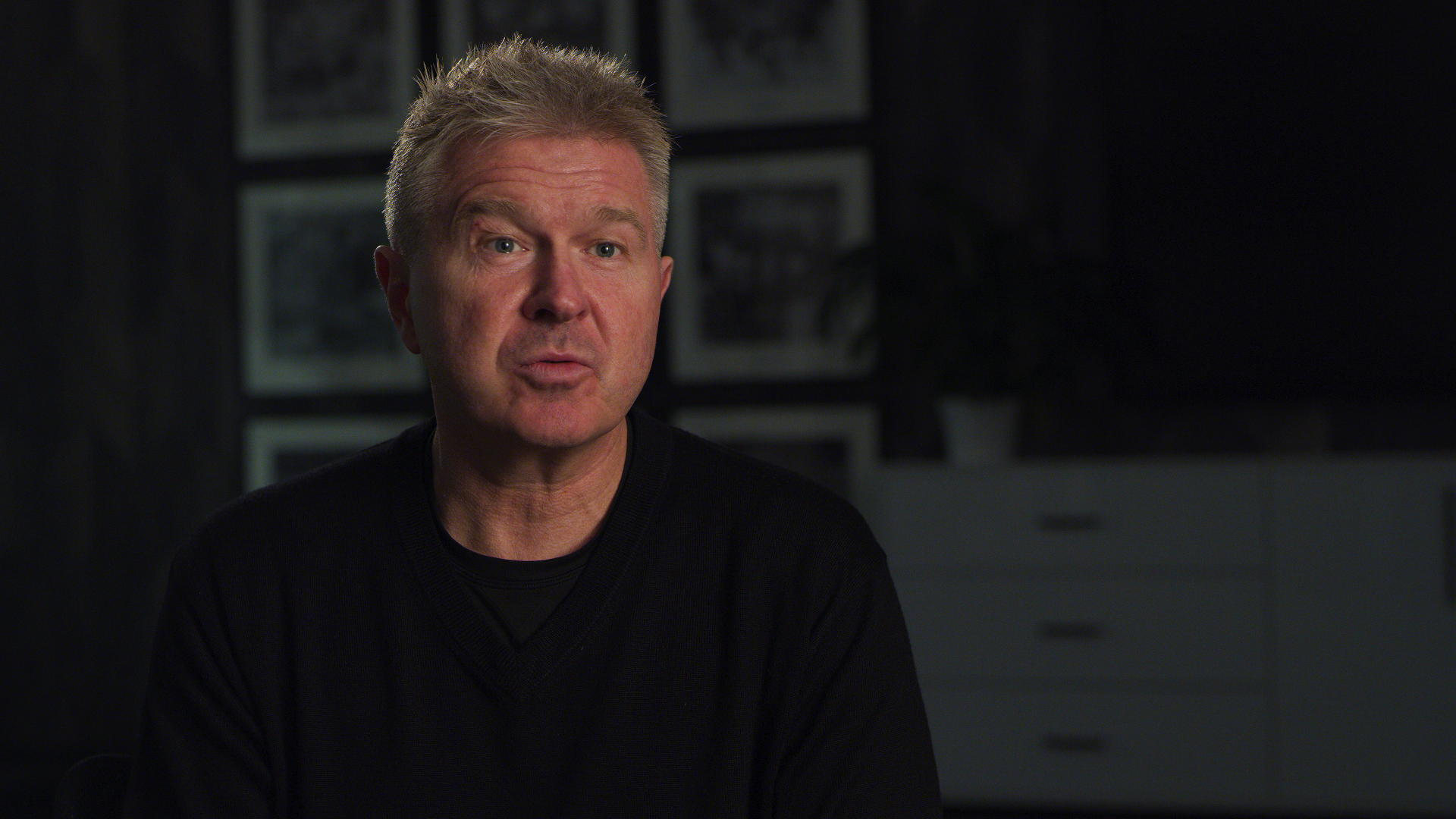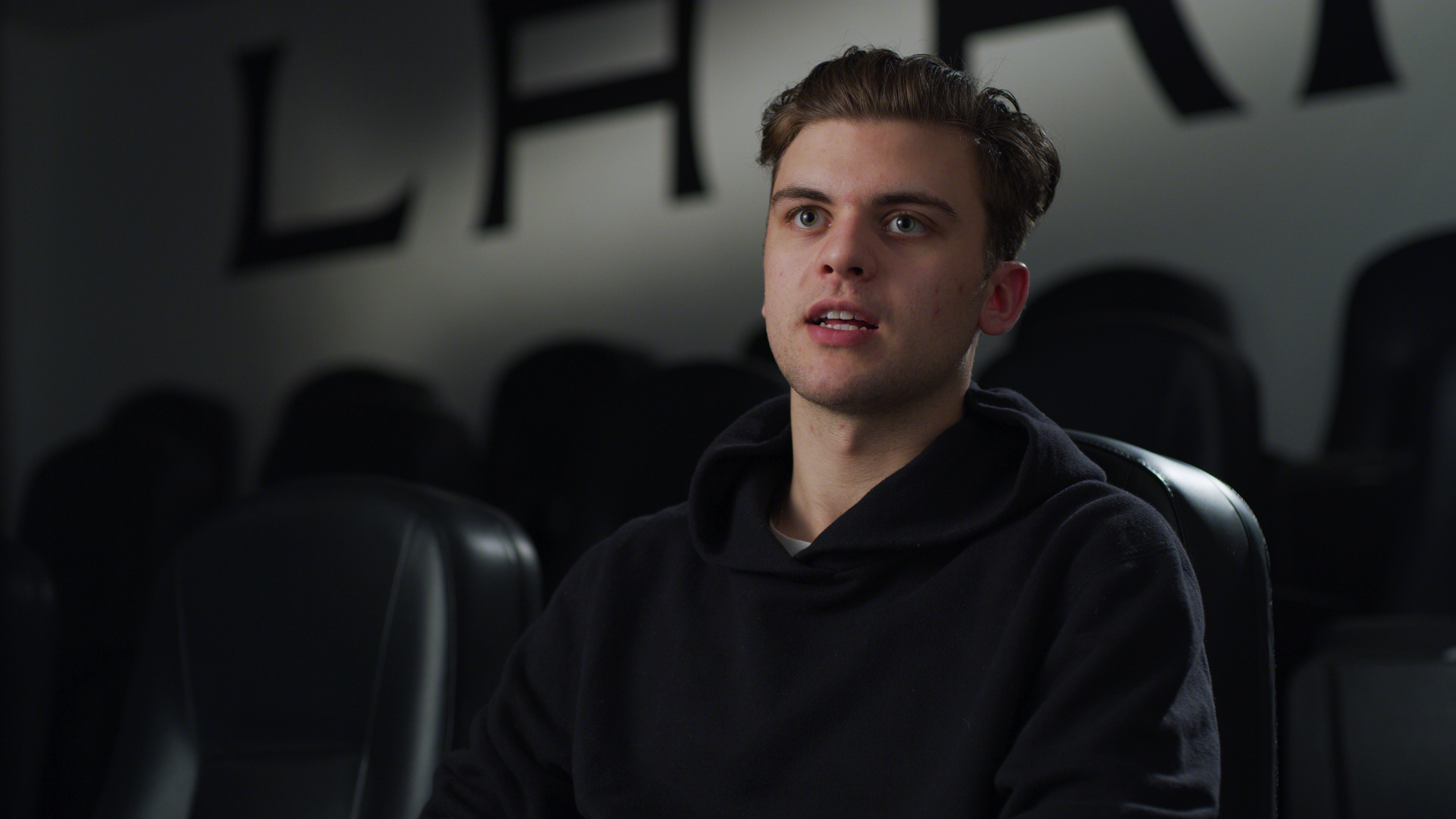
Royal Colors: Black and White
Chris Wohlers and Ryan Todd welcome AC behind the scenes while making the fourth season of the Los Angeles Kings' short-form documentary series Black & White.
Chris Wohlers and Ryan Todd welcome AC behind the scenes while making the fourth season of the Los Angeles Kings’ short-form documentary series Black & White.
Buffalo photos and all frame grabs courtesy of the filmmakers.
Additional photos by Jon D. Witmer.
“It’s all about what we can get that no one else is getting,” says Chris Wohlers, manager of production for the Los Angeles Kings of the National Hockey League.
Wohlers is leading the way through downtown L.A.’s Staples Center arena, where the Kings will soon be taking the ice to face off against the visiting Calgary Flames. During this Saturday-night game in early November, Wohlers and producer-editor Ryan Todd will be capturing footage for a planned episode of Black & White. Named after the Kings’ team colors, the short-form web series takes viewers behind the scenes of all facets of the Kings organization, both on and off the ice.
The episode at hand aims to paint a portrait of forward Ilya Kovalchuk, the team’s big offseason free-agent signing. And though Wohlers and Todd will capture footage during more than 30 of the Kings’ games over the course of this 82-game regular season, tonight marks a rarity, as they’ve been given approval to put a microphone on the player. This opportunity, Wohlers explains, represents “top-tier-level access” that comes along only a few times each season.
Beyond the in-game action, the plan is for this episode of Black & White to follow Kovalchuk off the ice with his family, whom he relocated from Russia to Beverly Hills after he signed with the Kings. As this season has been putting into stark relief, however, when it comes to sports, the best-laid plans are subject to change.
Case in point: After the team began the season well below expectations, the Kings fired head coach John Stevens just last Sunday, replacing him with interim head coach Willie Desjardins. The production crew went into high gear, shooting interviews with Desjardins, team president Luc Robitaille, vice president and general manager Rob Blake, and team captain Anze Kopitar on Monday, followed by Desjardins’ first game behind the bench on Tuesday. The resulting episode, “Fresh Start,” was released on Friday. “That was definitely the fastest one we’ve ever gotten out,” Wohlers notes.
Wohlers crosses through Staples Center’s Chick Hearn Press Room and into what’s labeled the Digital Dark Room, where the production, marketing and social-media teams have set up headquarters for the game. Inside, freelance sound recordist Glenn Gaines is prepping Kovalchuk’s lavalier mic, which will soon be handed off to head equipment manager Darren Granger and his crew to be sewn into the player’s uniform.
Todd soon enters the room, having completed the night’s first shot. He was in position at the base of the players’ entrance ramp with a Red Epic-W camera to capture Kovalchuk’s arrival and to follow him to the team’s locker room. With puck drop scheduled for 7 p.m., Todd and Wohlers have been at the arena since 3:45, allowing them to set up and be ready to grab such pregame moments.
The Kings’ 2018-19 season corresponds with the fourth season of Black & White, a series that began production just after the Kings’ hoisted the Stanley Cup as NHL champions for the second time in three years and the second time overall in team history. Wohlers joined the production staff during the series’ first season, while this marks Todd’s second season behind the camera. Following Wohlers’ arrival, the team invested in a Canon EOS C300 — which remains the crew’s workhorse for 4K 24-fps in-game footage — and, more recently, the Epic-W; the latter is used to capture 4K footage at 120 fps, as well as for interviews, which are shot single-camera in 8K at 24 fps. Both cameras are typically kept at 800 ISO; when shooting game footage, Todd notes, “it’s so bright on the ice, we’re usually shooting at T5 or 5.6.”

Complementing the cameras, the production crew carries a set of lenses that includes Canon EF 16-35mm, 24-70mm and 70-200mm (all f/2.8) zooms, a Sigma 18-35mm (T2) High Speed cine zoom, and a 50mm (T1.5) Sigma FF High Speed cine prime.
Joined by supervisor of production Trevor Rabone and creative director Ashley Jordan Lane, Wohlers, Todd and Gaines set off to take their positions for the pregame warm-ups, discussing Black & White’s upcoming docket as they go. They’ve already started following broadcasters Francisco X. Rivera and Nano Cortés, who this season are calling 10 Kings games in Spanish for radio station ESPN Deportes. Defenseman Dion Phaneuf will soon appear in his 1,000th NHL game, which will happen in Nashville; upon the team’s return to Staples Center, he’ll be saluted on-ice in a pregame ceremony. And in December, Wohlers and Todd hope to travel to Buffalo for an episode focusing on forward Alex Iafallo and his family.
The Black & White crew works closely with Kings’ broadcast partner Fox Sports West to get additional in-game footage as well as pre- and postgame interviews when necessary. During the game, Wohlers points out, “Fox is getting everything wide, so what can we get that’s different?”
To that end, Wohlers will take the C300 to the broadcast camera-well midway up the stands and overlooking center ice; from that vantage, he’ll get shots looking toward the Kings’ bench, isolating Kovalchuk. Todd, meanwhile, will be at ice level, right up against the glass, in one of the still photographers’ photo wells, capturing high-speed game action. Additionally, Rabone will rig three GoPro Hero4 Black cameras on the Kings’ bench to catch Kovalchuk in between his shifts on the ice. “It’s so precious to have a guy mic’d up,” Wohlers stresses. “Knowing that every second is on-camera is very big for us.”
Kovalchuk is on tonight’s starting line, skating alongside forwards Jeff Carter and Tyler Toffoli, with defensemen Drew Doughty and Derek Forbort in front of goaltender Jack Campbell. Todd heads out onto the ice to shoot the players’ introductions, keeping his camera trained on Kovalchuk throughout. After the national anthems, he hurries into position behind the glass, near the corner where the Zamboni enters and exits the ice between periods. He places the Epic-W on a tripod, facing across ice toward the Calgary bench; the Flames’ net will be on this end for the first and third periods, making it a prime location to capture Kovalchuk and the Kings’ offense in action.

For the second period, AC follows Wohlers to the upper camera well. Gaines is seated just in front of Wohlers’ position, monitoring the audio recording. From this perch, he can stand up and turn around to speak with Wohlers when the referee’s or linesmen’s whistles stop the play on the ice; when there’s something to say during the game action, the two filmmakers communicate via text.


Heading into the third period, the Kings are down 1-0. They get two power-play opportunities in the second half of the final frame, and they pull goaltender Jack Campbell for an extra skater with 59 seconds remaining, but ultimately they’re unable to score. Had the Kings tied the game and sent it to overtime, the teams would have switched ends of the ice, and Todd would have run to the other end of the rink and operated the camera handheld. Then, had the Kings managed to win, he would have gone out onto the ice to capture the players lifting their sticks in salute to the fans.
Instead, when the horn blows to end the game, the team heads straight to the locker room, and the production crew returns to the Digital Dark Room for a quick wrap-out. The footage they’ve captured will remain on the CF cards and Red Mini-Mags until the crew returns to the team’s offices at Toyota Sports Center in El Segundo on Monday.
As they carry their gear out of Staples Center, Todd says to Wohlers, “Well, we got something.”

Whatever it was, we’ll never know.
Almost two months later, in early January, Wohlers and Todd welcome AC through double doors emblazoned with the Kings’ crown logo, into the team’s primary base of operations at Toyota Sports Center. After its inauspicious start, the difficulty of getting the Kings’ season back on track has been compounded by a long string of injuries to players up and down the lineup, including Kovalchuk, who missed 10 games with an injury that required ankle surgery. Given that turn of events, the decision has been made to shelve his episode of Black & White.
“That’s something we knew could happen,” Wohlers notes, “but it’s the first time we’ve pulled the plug in the middle of production.”
Thankfully, other plans have borne fruit. The ESPN Deportes and Dion Phaneuf episodes (“Growing the Game” and “Phaneuf’s 1,000th,” respectively) have both been released, and Wohlers and Todd did travel to Buffalo for the Iafallo-family episode, which, at the time of AC's visit, is being edited.
The two filmmakers lead AC through the TSC complex, where the Kings — as well as their American Hockey League affiliate, the Ontario Reign — have their practice facility, replete with separate locker rooms for each team, three sheets of ice, a full gym, a team lounge, and more. Todd notes that there’s no designated place to shoot interviews for Black & White, so they commandeer space as the need arises — most often using the team’s theater on the ground level or, more recently, a conference room on the second floor.


To light those interviews, Wohlers says they have “a three-light Litepanels kit and a standard Arri kit,” the latter of which features two 300- and two 650-watt Fresnels. “We usually use [a Litepanels 1x1] through 216 diffusion for the key light, and sometimes we’ll put a bounce for fill. Then we’ll use the Fresnels for a backlight or to accent the walls in the background. We try to do pretty high contrast to make it a little moodier.”
Wohlers and Todd handle sound duties themselves for those on-site interviews, and they also wore that extra hat on their trip to Buffalo, which was a particularly bare-bones affair. “We didn’t bring any lights,” Todd explains. “We just used available lighting and worked with what we had.”
One piece of special equipment they did take was the production team’s DJI Phantom 3 drone, which made its Black & White debut with “Sutter Farm,” a 2016 episode that spotlighted then Kings coach Darryl Sutter at his offseason home in Viking, Alberta, Canada. “It adds a ton [of production value],” Wohlers says. “Ryan is a good drone pilot, so he flies it now.”
The production team’s offices are on the 2nd floor of the practice facility, with social media and marketing sharing the same space. The departments’ combined creative efforts have resulted in an ever-expanding portfolio of projects for Wohlers and Todd to tackle, including promo videos for social media, as well as other series including “Inside the Play,” in which Kings players break down specific moments from recent games, and “In the Pipeline,” which spotlights the team’s up-and-coming players. “I’d say Black & White is about 20 percent of what we shoot, if that,” Wohlers says.
A door in the back corner of the creative department leads to the office of senior editor Phillip Radke. Adobe Premiere Pro CC is open on the two large Dell monitors on his standing desk; on one, the Buffalo episode assembly sits on a 1080 timeline, and on the other, Radke is scrubbing through footage of the Ohio State University’s women’s hockey team, on which Iafallo’s sister Julianna served as a captain before turning pro.

The Buffalo trip involved shooting two hockey games — Alex’s with the Kings and Julianna’s with the Buffalo Beauts of the National Women’s Hockey League — as well as multiple days off-ice with the family. “This is probably the most we’ve ever shot for one Black & White,” Wohlers notes. “We know what the idea is for the story, but how does it actually become digestible? That’s what Phil has to figure out. Phil makes it come alive in the edit."
“There are two dynamics an episode can play into,” Wohlers continues. “There’s critical stuff that’s happening, like if a guy has a 1,000th game or a coach is fired. That’s the simple aspect; we just follow what happens. And the other — which I think is more fun but harder [to execute] — is stuff like this Iafallo episode, and the Deportes one, too, which Ryan edited. What are the stories ‘outside’ of the season? These stories are topical, but [in a certain regard] they also have nothing to do with hockey.”
Color correction for Black & White happens as part of the editorial workflow. “We’re all about speed, so we don’t do anything fancy,” Radke offers. “Ryan’s experimented a little with Resolve, but that plays into our turnaround time and budget. That’s the next way we can upgrade what we’re doing.”
Radke’s responsibilities also extend to managing the server and overseeing the department’s archiving efforts, backing up all content — raw footage as well as finished projects — from each season to LTO 6 tape, with one copy to keep at TSC and one for storage off-site. “By the end of the year, there’s just so much stuff,” Wohlers notes, “so organizing is a huge part of it.”
Not too long ago, when the Kings were winning their two Stanley Cups, the NHL game was viewed as “heavy” and defensively oriented. Since then, it’s been evolving into a game of speed and skill that increasingly emphasizes offense first. That the Kings as an organization allow their own evolution to be examined in close-up by Black & White’s cameras isn’t taken for granted by the filmmakers.
“The fact they let us do stuff like this can’t be overstated,” Wohlers says. “They believe this is something people will want to see and that can help build the fan base. They’ve believed all along that it could be something big.”
Every episode of Black & White can be found on the Kings' YouTube channel.







